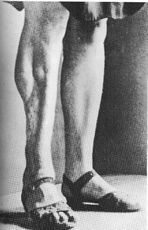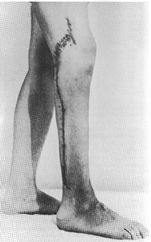 |
|
The above picture shows a leg of one of the 74 Polish victims subjected to medical experiments in the Ravensbrück concentration camp The Hippocratic Oath has been taken by all doctors for twenty six centures: "The regimen I adopt shall be for the benefit of my patient, according to my ability and judgement, and not for their hurt or for any wrong." |
The experiments conducted on Polish political prisoners in Ravensbrück by Nazi doctors fall into two groups.
Group one aimed at testing the efficiency of sulphonamide drugs. This was done by deliberately wounding the selected victim and by introducing various virulent bacteria (staphylococci, gas bacilli) into the wound after which the patient was given one of the tested drugs. Whatever the scientific result of these experiments the fact remains that they were invariably very painful and often resulted in the patient's death or permanent bodily injury.
Experiments in group two aimed at studying the processes of regeneration of bones, muscles and nerves, and also the possibilities of transplanting bones from one person to another. The operations consisted of breaking up. dissecting and grafting bones, muscles and nerves. They caused unbearable pains and resulted in lifelong infirmity due to the permanent injury inflicted to bones, nerves and muscles.
Operations in group one, devised to test the efficacy of sulphonamide drugs, were performed in three series by the doctors Gebhardt and Fischer who began by experimenting on 15 prisoners transferred from Sachsenhausen to Ravensbrück for this particular purpose. According to Dr. Fischer's statement made before the American prosecutor on November 21, 1945 (Nuremberg Trial - document No. 228) the motive behind these experiments, their purpose and technique can be summed up as follows: The method of conducting the experiment was first discussed and a date fixed for the beginning of any series. The medical officer of Ravensbrück camp was notified of the appointed date and advised as to the number of human guinea-pigs who would be the victims made on the outer side of the calf and a bacteria mixture supplied by the Waffen SS Institute of Hygiene, was rubbed into the wound. The incision was then sewn up and dressed with a cotton-wool filled plaster cast. Dr. Fischer made visits from Hohenlychen to Ravensbrück everyday to check the progress of this artificial infection and reported on it to Dr. Gebhardt. The first series of experiments performed on 15 prisoners having failed to yield the expected result, were suspended for a fortnight. Dr. Gebhardt, in the meantime, went to Berlin to submit his report to his SS authorities, and stated on his return that the experiments were to be continued and that from then on groups of Polish women prisoners in Ravensbrück camp were going to be used as guinea-pigs. As the results yielded by the first series of experiments performed on Sachsenhausen prisoners, were regarded as inconclusive for wound-infections likely to occur under front-line conditions, the Institute's of Hygiene advice had been sought on the matter. After an exchange of letters with the Institute and after a conference on the subject held at Hohenlychen it was decided to introduce some changes into the new series: besides the bacteria also wood and glass splinters were to be introduced into the artificially made wounds to create conditions similar to those on the battlefield.
 In
the first series of experiments made according to this newly adopted pattern,
the Polish women were divided into three groups all of which received
their quota of bacteria and in addition, group I, had their incisions
infected with fragments of wood, group II - with glass splinters and group
III with both wood and glass. Two weeks after the beginning of this series
Dr.Grawitz, Reich physician SS arrived at Ravensbrück to make a personal
inspection and investigate the results of the experiments. After hearing
Dr. Gebhardt's and Dr. Fischer's reports he concluded that the conditions
under which the experiments were fields and that the incisions were mere
"flea-bites". In order to achieve more conclusive results, experiments
should be made with real gunshot wounds like those received under front-line
conditions. However, the method of inflicting wounds by using firearms
was not applied and only the technique of making incisions was changed.
By tying up the blood vessels on both sides of the wound the circulation
was stopped thus achieving conditions not unlike what might be expected
in a shot wound. Two series of experiments were made by this method and
neither wood nor glass was used in the first series. In all the cases
in which the infection reached a certain development stage, the patients
were given sulfonamide drugs to see how effectively they worked. Two of
the women operated on in each series, however, were given no drugs so
that their efficiency might be tested still better by comparing the respective
results.
In
the first series of experiments made according to this newly adopted pattern,
the Polish women were divided into three groups all of which received
their quota of bacteria and in addition, group I, had their incisions
infected with fragments of wood, group II - with glass splinters and group
III with both wood and glass. Two weeks after the beginning of this series
Dr.Grawitz, Reich physician SS arrived at Ravensbrück to make a personal
inspection and investigate the results of the experiments. After hearing
Dr. Gebhardt's and Dr. Fischer's reports he concluded that the conditions
under which the experiments were fields and that the incisions were mere
"flea-bites". In order to achieve more conclusive results, experiments
should be made with real gunshot wounds like those received under front-line
conditions. However, the method of inflicting wounds by using firearms
was not applied and only the technique of making incisions was changed.
By tying up the blood vessels on both sides of the wound the circulation
was stopped thus achieving conditions not unlike what might be expected
in a shot wound. Two series of experiments were made by this method and
neither wood nor glass was used in the first series. In all the cases
in which the infection reached a certain development stage, the patients
were given sulfonamide drugs to see how effectively they worked. Two of
the women operated on in each series, however, were given no drugs so
that their efficiency might be tested still better by comparing the respective
results.
 Another
series of experiments aimed at investigating the infection of soft tissues
into which virulent bacteria had been introduced by injection. This kind
of experiment was made by two methods. Several women were given subcutaneous
or intramuscular injections of a substance containing pathogenic germs
which caused local infection with inflammation, swelling, pain, soaring
temperatures, headaches and even hallucinations. After a time the patients
were given intravenous or intramuscular injections of new and yet untested
drugs to check how efficient they were in fighting artificially produced
infections. The other method consisted in giving injections which produced
local infection and in making long and deep incisions in addition. This
also was devised to test the effects of new drugs given in the form of
intravenous or intramuscular injections. All the experiments belonging
to this group were performed for the purpose of establishing the efficacy
of sulphonamide drugs.
Another
series of experiments aimed at investigating the infection of soft tissues
into which virulent bacteria had been introduced by injection. This kind
of experiment was made by two methods. Several women were given subcutaneous
or intramuscular injections of a substance containing pathogenic germs
which caused local infection with inflammation, swelling, pain, soaring
temperatures, headaches and even hallucinations. After a time the patients
were given intravenous or intramuscular injections of new and yet untested
drugs to check how efficient they were in fighting artificially produced
infections. The other method consisted in giving injections which produced
local infection and in making long and deep incisions in addition. This
also was devised to test the effects of new drugs given in the form of
intravenous or intramuscular injections. All the experiments belonging
to this group were performed for the purpose of establishing the efficacy
of sulphonamide drugs.
The second group, which began in mid-August 1942 and continued on and off until August 16,1943, was devised to examine the processes of regeneration of bones, nerves and muscles and removing sections of the muscles on the thigh and calf and in many cases the same victim was several times submitted to such surgical experiments which resulted in bodily weakness, incapacity of the limbs and in severe pain. Nerve operations consisted in removing parts of the nerves of the lower limbs. Experiments on bones consisted of breaking (osteoclasis), grafting and (osteotomy) splitting. The performing of an osteoclasis operation took up to three hours during which the bones of the lower limbs were broken sometimes in several places and then re-set. The wound was then stitched up and given plaster cast dressing. This cast used to be removed before the bones had time to set so that the process of regeneration might be studied while testing the efficacy of various healing methods. Transplantation of bones consisted in grafting parts of the left tibia on the right leg and vice versa, also of grafting the fibula onto the tibia. Parts of the fibula were sometimes removed altogether. Osteotomies were performed in two operations: during the first, rectangular incisions were made on both tibiae and these incisions or "splinters" were removed during the second operation. No less than six incisions were made on one occasion. The study of the process of regeneration in the osseous tissues was the main purpose of these experiments, but also, according to Dr. Stumpfegger's words - they were meant to help to solve some problems in plastic surgery, which would have wide application after the Second World War was won by Germany. All the bone operations were extremely painful and they caused permanent deformities.
The results of these experiments were widely discussed at a conference of SS medical officers and civilian doctors held in Berlin on May 24-26, 1943. The fact that several of the operations had caused the patient's death was mentioned in a detailed report on the experiments on Polish women prisoners in Ravensbrück, presented at the conference by Drs. Gebhardt and Fischer. The German doctors present at the conference questioned the two experimentalists on points of professional interest but no voice was raised in protest at the criminal cruelty of the experiments.
The last series of experiments, which was started on August 16, 1943, was performed in the camp prison under direct physical force exerted by the SS wardens in view of the violent resistance put up by the Polish women selected to serve as guinea-pigs. Many of the Polish victims have given their evidence before the American Military Tribunal sitting in Nuremberg and before Polish juridical authorities. Their testimony illustrates the nature of the experiments, the "after care" received by the patients, the mental and physical injuries inflicted on the victims.
The above text comes from "Guinea-pigs" of Ravensbrück. A retrospection by Kazimierz Leszczyński ,Experimental Operations On Prisoners of Ravensbrück Concentration Camp, Studies and Monographies, December 1960, Edited by Wanda Machlejd.